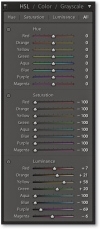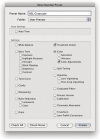Fine-tuning black-and-white images
Split Toning panel
As long as you have a good profile for your printer or you are using a printer and ink combination specifically designed for black-and-white work, it should be fairly easy to obtain a neutral gray print. It should not even matter how well your display is calibrated. If an image is in black and white, you should be able to produce a perfectly neutral gray print regardless of how neutral the photo looks on the display. If you are unable to achieve neutral black-and-white prints, there may be something wrong with your printer profiles. Or, if you're using an inkjet printer, the print heads may need cleaning. This is a good point to bear in mind. Often, I have gone to make a print and the colors have been distinctly off, and all because it had been several weeks since I had last used that particular printer. Usually, a quick nozzle clean is all that's required.
The Split Toning controls (Figure 7.6) are mainly intended for use on photos after they have first been converted to black and white, where you want to deliberately add some color to the otherwise neutral tones in the image. The Hue sliders can be used to adjust the hue color in either the highlights or the shadows, and the Saturation sliders can be used in conjunction with the Hue sliders to apply varying strengths of color. Note that if you hold down the  key as you drag a Hue slider, you get a saturation-boosted preview that can help you see more clearly which hue color you are selecting without having to change the Saturation slider setting. In Lightroom, we have a color picker (Figure 7.7) that allows you to select the hue and saturation more easily in one step. To choose a color, click a swatch to open the color picker, and then click anywhere in the color ramp, or anywhere in the interface screen area even. Just click in the color ramp, and with the mouse held down, drag outside of the color ramp to anywhere on the screen. But remember, this only works if you keep the mouse held down as you drag. You can also save a new color swatch by
key as you drag a Hue slider, you get a saturation-boosted preview that can help you see more clearly which hue color you are selecting without having to change the Saturation slider setting. In Lightroom, we have a color picker (Figure 7.7) that allows you to select the hue and saturation more easily in one step. To choose a color, click a swatch to open the color picker, and then click anywhere in the color ramp, or anywhere in the interface screen area even. Just click in the color ramp, and with the mouse held down, drag outside of the color ramp to anywhere on the screen. But remember, this only works if you keep the mouse held down as you drag. You can also save a new color swatch by  -clicking in the swatch boxes to the left of the main before/after color swatch box. You will notice that the color picker displays both the highlight and shadows color positions on the color ramp, so you can judge the relative positions of the two color sample points. There is also a slider at the bottom that you can use to adjust the saturation while keeping the hue value locked.
-clicking in the swatch boxes to the left of the main before/after color swatch box. You will notice that the color picker displays both the highlight and shadows color positions on the color ramp, so you can judge the relative positions of the two color sample points. There is also a slider at the bottom that you can use to adjust the saturation while keeping the hue value locked.

Figure 7.6 The Split Toning panel.

Figure 7.7 To access the color pickers, click on the swatches and click anywhere in the color ramp to sample a new color. The current selected color is the one with the thicker border.
The Balance slider in the Split Toning panel lets you offset the balance between the shadow and highlight color toning and provides a really nice fine-tuning control for your split tone effects.
With the Split Toning controls in Lightroom, there are no hard-and-fast rules as to which color combinations to use. It can sometimes be useful to pick contrasting colors, such as a blue color for the shadows and a warm color for the highlight tones. The following two examples will give you an idea of what's possible.
- This photo was first converted to black and white using the B&W panel controls.
- I then went to the Split Toning panel and used the color picker to select a warm sepia color for the highlights and a cool color for the shadows. Finally, I offset the split tone midpoint by adjusting the Balance slider.
Split-toning a color image
The Split Toning controls also work great on non-black-and-white-converted, color images. If you want to give your photographs that distorted color look, here's how you can create a cross-processed effect in Lightroom. It is really easy to vary the effects shown here and save successful color split tone effects as presets.
- This is the same shot that was used to demo the Auto black-and-white conversion technique, except here I started with a neutral white-balanced version where I had applied only a few Basic panel adjustments.
- The color effect you see here was achieved using the Split Toning panel controls. In this example I tried to simulate a typical cross-processed film look, which I did by setting the highlights hue to yellow and the shadows hue to a cyan/blue color. I could have achieved a more subtle effect than the one shown here by reducing the Saturation amount for the highlights and the shadows, but the settings used here produced a fairly typical cross-processed look. You will notice that I also offset the Balance slightly to add more weight to the cyan/blue coloring in the shadows.
HSL panel: Desaturated color adjustments
Lightroom offers another less obvious approach to converting color images to black and white. If you go to the HSL panel and drag all the Saturation sliders to -100, you can desaturate the color completely to create a black-and-white version of a photo. On the face of it, this would appear to be the same thing as dragging the Basic panel Saturation slider all the way to the left, but the key difference here is that the Saturation slider applies its adjustment upstream of all the other color sliders, thus rendering them inoperable (apart from White Balance, Color Noise, and Calibration). But the HSL desaturate method cleverly gives you full access to all the color controls in the Develop module, and this is where it can sometimes score favorably against B&W panel adjustments.
Here is how to get started. Go to the HSL panel and set all the Saturation sliders to -100 (as shown in Figure 7.8). That's it. Don't adjust the Luminance sliders just yet, as you'll be doing that later. For now, I suggest you follow the advice given in Figure 7.9 and save this HSL setting as a new preset. At the end of Chapter 6, I suggested that you use folders to organize your develop presets, so my advice here is to save a setting like this to a dedicated folder for storing HSL black-and-white presets such as the HSL Black & White folder used in Figure 7.9.

Figure 7.8 The HSL panel showing all controls with the Saturation sliders all set to -100.

Figure 7.9 When saving an HSL desaturate setting (such as the one shown in ) as a new develop preset, check the Color Adjustments box only, as shown here.
The HSL B&W method
With HSL black-and-white conversions, all you need to do is apply the preset that was saved in Figure 7.9 and then adjust the HSL panel Luminance sliders. Don't bother editing the Hue sliders—these will have no effect on the black-and-white conversion. The Luminance sliders can, therefore, be used to lighten or darken specific colors in the photo, just as you would when adjusting the B&W panel sliders. The Target Adjustment tool can also be used here. Click the Target Adjustment tool button to activate it, or use the  (Mac) or
(Mac) or  (PC) keyboard shortcut to switch to Target Adjustment mode and
(PC) keyboard shortcut to switch to Target Adjustment mode and  (Mac) or
(Mac) or  (PC) to exit this tool mode behavior. (Figure 7.8 shows how the HSL panel might look after you have finished adjusting the Luminance sliders.) If you want, you can save an HSL black-and-white setting as a new preset, in which case you would click the plus button in the Presets panel and again use the same Develop settings shown in Figure 7.9 to create a new preset.
(PC) to exit this tool mode behavior. (Figure 7.8 shows how the HSL panel might look after you have finished adjusting the Luminance sliders.) If you want, you can save an HSL black-and-white setting as a new preset, in which case you would click the plus button in the Presets panel and again use the same Develop settings shown in Figure 7.9 to create a new preset.
So far you might think this is a long-winded approach for producing exactly the same results as you can achieve with the B&W panel on its own. But as I mentioned earlier, when you work with the B&W panel, the Vibrance and Saturation sliders are unavailable and are shown grayed out. This is a shame, because when you use the HSL desaturate method, the Vibrance and Saturation sliders offer you a great deal of added control over the outcome of your black-and-white conversions. In HSL desaturate mode, the Saturation slider in the Basic panel can act like an amplifier volume control for the HSL Luminance adjustments. So, increasing the Saturation magnifies the HSL slider settings. The Vibrance slider offers a more subtle, fine-tuning control. But, interestingly, a Vibrance adjustment can sometimes appear to have an opposite effect to the Saturation slider, and decreasing the Vibrance can sometimes make certain colors (such as blue) appear darker when converted to black and white. This conversion method is perhaps more suitable for red contrast-type conversions where you might want to significantly darken a blue sky. I wouldn't say it is essential to use this approach in every case, because not all black-and-white conversions are likely to require this alternative method. But the following steps illustrate a typical example of a black-and-white conversion that might suit the HSL desaturate technique.
Camera Calibration adjustments
I have not mentioned this before, but you can also use the Camera Calibration panel sliders to apply further fine-tuned adjustments. Here, things get a little unpredictable, and it can be a matter of playing with the sliders and seeing what happens. But, even so, this method still offers more opportunities for experimentation that are otherwise lacking with the standard Lightroom black-and-white conversion methods.
- In this photograph, just a few minor adjustments were made to the settings in the Basic and other panels.
- This shows how the photograph looked when converted to black and white with the HSL Saturation sliders all taken to -100. (I also added a Split Tone effect.)
- In the HSL panel, I used the Luminance sliders to adjust the black-and-white conversion mix, just as I would in the B&W panel; plus, I reduced the Vibrance.
- Finally, I went to the Camera Calibration panel and adjusted the Blue Primary Hue and Saturation sliders to add even more contrast to the sky.







